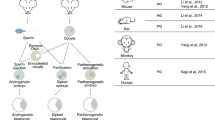Abstract
NATURAL alterations in the number of chromosome sets appear to be uncommon among the somatic tissues of animals. Somatic haploidy has been claimed to occur in the micromeres of sea-urchin embryos1, and in the tail mesenchyme of tadpoles2. The former case was quickly denied3, while the latter is also better interpreted as the pairing of homologous chromosomes. Polyploidy is well known in mammalian liver and in various tumours, but rarely in other tissues.
Similar content being viewed by others
References
Lindahl, P. E., Nature, 171, 437 (1953).
Green, E. U., Nature, 172, 766 (1953).
Makino, S., and Alfert, M., Experientia, 10, 489 (1954).
Wallace, H., J. Morph., 112, 261 (1963).
Wallace, H., Quart. J. Micro. Sci., 103, 25 (1962).
Elsdale, T. R., Fischberg, M., and Smith, S., Exp. Cell Res., 14, 642 (1958).
Kahn, J., Quart. J. Micro. Sci., 103, 407 (1962).
Author information
Authors and Affiliations
Rights and permissions
About this article
Cite this article
WALLACE, H. A Case of Somatic Polyploidy. Nature 199, 1115–1116 (1963). https://doi.org/10.1038/1991115b0
Issue Date:
DOI: https://doi.org/10.1038/1991115b0
- Springer Nature Limited
This article is cited by
-
Alternative Model for Gene Amplification
Nature New Biology (1971)





